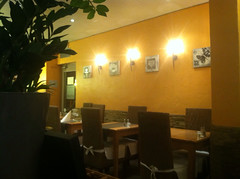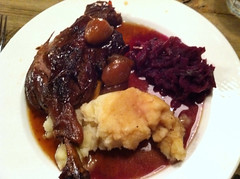Epen, February 26, 2012—
I FIRST VISITED The Netherlands in 1973, and we've returned many times over the years. Our daughter's Dutch adopted family, with whom she lived on an exchange year 1975-76, is as close to us as our own family. We've walked the length and breadth of the country. I love Netherlands as fondly as I do my own country — which I consider to be Sonoma county, California.
But I'll be the first to agree that for many years the food you'd get in restaurants when visiting this country was, well, pretty bad. Overcooked meat and vegetables and lots of potatoes, that's what it was, and I mean
lots of potatoes. One night we had three dishes of potatoes: fried; mashed; steamed. I think we were being tested, to see if we were paying attention.
Then in the 1980s things began to change. You could still get traditional Dutch fare — govercooked mystery meat and too many side dishes of vegetables whose only escape from blandness came from liberal sprinklings of nutmeg — but Dutch travelers had enjoyed Italy; a number of them decided flavor was worth paying for; and government schools embraced the "Horeca" Field — hotel, restaurant, café — as a likely important sector of the economy to come.
We've spent a lot of time and a number of guilders, more recently euros, in horeca in the last thirty years, and I must say food here has become more consistant, and more consistently good, than in any other country we regularly visit but Italy. But this came, at first, partly at the cost of a recognizably individual national cuisine.
Some would say good riddance: not me; I like local distinction, and had always found the principles of Dutch cookery attractive and attractively familiar from my middle-class semirural upbringing. It was pleasant to find engaging mainstream Italian cuisine in provincial Dutch cities, but I missed the attempt to rescue the local traditions.
But beginning say fifteen years ago something's changed again, and the provincial table has begun to reclaim those traditions, proudly asserting local culinary repertoire and even rediscovering long-forgotten vegetables like salsify.
Dinner tonight in the restaurant of an old-fashioned country hotel was nothing exceptional; certainly not after the previous two evenings, when our food was devised and prepared by professionals who've served their time at Chez Panisse among a number or top-class restaurants. But it was sound and competent and attractive, and grounded in the old Dutch traditions — with the slightly Belgian accent you'd want in this most southerly corner of Dutch Limburg.
We began with a nice light salad subtly incorporating very thin-sliced celery for texture among its lettuces, alongside thin slices of ham — Serrano, not Dutch — set off with rich, sweet red onion compote. A braised half poussin came next, in its cream mustard sauce, traditional to the neighboring town Gulpen, with green beans, snow peas and carrots on the side, and a side dish of buttery roasted whole little potatoes.
Dessert was a plate of ice creams and cold soufflées: vanilla, strawberry, and light chocolate, with dark chocolate sauce and whipped cream on the side — a deconstructed hot fudge sundae, in fact, nicely balanced. Even the wine was local — and surprisingly satisfactory.
Chasselas, I think: Domein Le Coq Frisé "Cuvée des Amis" (Epen, Limburg), 2010
•Hotel Herberg de Smidse, Molenweg 9, Epen, Netherlands; +31 043 455 1253Location:Epen, Netherlands













